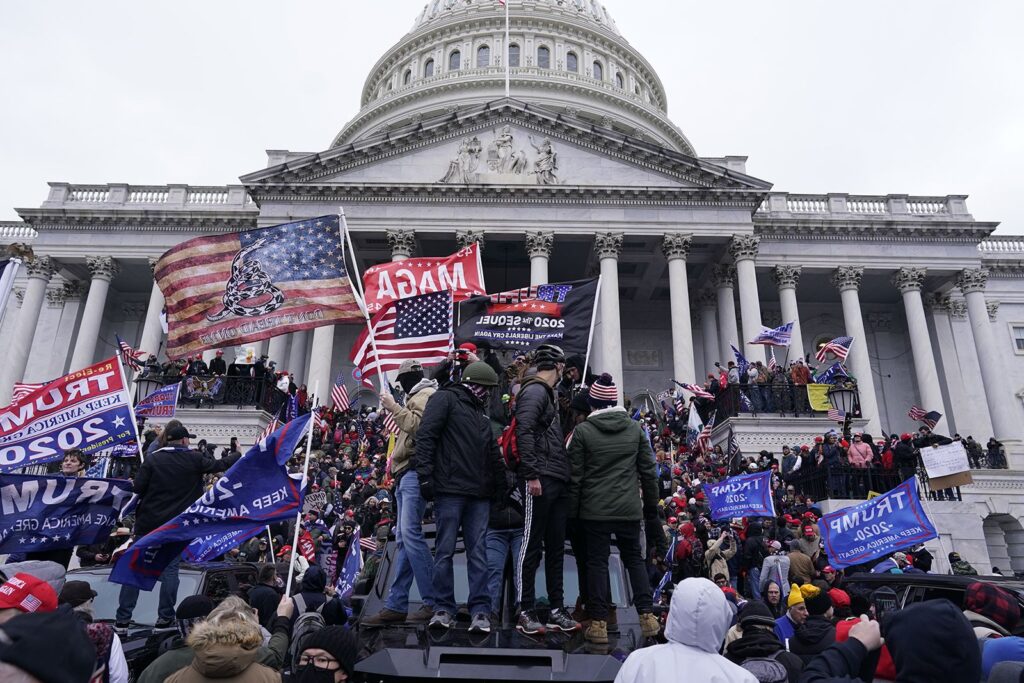Note: If you wish to receive, via e-mail, (1) my weekly newsletter or (2) daily copies of these posts, notify me at rrbates1951@gmail.com and indicate which you would like. I promise not to share your e-mail address with anyone. To unsubscribe, send me a follow-up email.
Tuesday
One problem with MAGA’s rhetoric of violence is that different figures compete for who can sound the most bloodthirsty. While it’s difficult to decide who wins the prize, Ron DeSantis’s “We’re going to start slitting throats on Day 1” is up there. The reference is to downsizing the federal bureaucracy.
Incidentally, this is a man who has investigated violent death. As a 27-year-old Navy lawyer in 2006, he was on the team looking into three Guantanamo prisoners found hanging from their necks, their hands and feet bound and rags in their throats. (The lawyers found no evidence of foul play.)
Washington Post columnist Paul Waldman recently wrote an article for MSNBC’s on-line magazine that puts the escalating rhetoric in perspective. Although the January 6 insurrection failed, what remains is MAGA’s thirst “to solve their problems with spasms of redemptive violence.” This thirst, Waldman adds, is “being fed every day, by elite figures on the right who believe they can harness the bloodlust they reinforce for their own ends.”
Waldman glumly concludes, “And we don’t yet know whether next time will be even harder to contain.”
I first came across the notion of redemptive violence in Richard Slotkin’s series of studies on the frontier myth of the frontier, which included Regeneration Through Violence: The Mythology of the American Frontier, 1600–1860; Fatal Environment: The Myth of the Frontier in the Age of Industrialization, 1800–1890; and Gunfighter Nation: Myth of the Frontier in Twentieth-Century America. Slotkin’s central thesis is that, throughout our history, many have regarded “the redemption of American spirit” as being achieved “through a scenario of separation, temporary regression to a more primitive or ‘natural’ state, and regeneration through violence” (Slotkin’s italics).
“The core of that scenario,” Slotkin explains, is
the symbol of “savage war,” which was both a mythic trope and an operative category of military doctrine. The premise of “savage war” is that ineluctable political and social difference—rooted in some combination of “blood” and culture—make coexistence between primitive natives and civilized Europeans impossible on any basis other than that of subjugation. Native resistance to European settlement therefore takes the form of a fight for survival, and because of the “savage” and bloodthirsty propensity of the natives, such struggles inevitably become “wars of extermination” in which one side or the other attempts to destroy its enemy root and branch.
A literature professor, Slotkin turns to narrative to track the myth, starting with early Indian captivity narratives and Daniel Boone stories and the writings of James Fenimore Cooper, Nathaniel Hawthorne, Henry David Thoreau and Herman Melville. He concludes, in Gunfighter Nation, with the western and crime genres, both in literature and film. Over the years, Indians have been replaced in this frontier drama with immigrants, labor activists (“socialists”), Muslims, LBGTQ+ folk, and, above all, urban Blacks. Sometimes the rhetoric is broadened to include all Democrats, with Waldman providing examples:
The audience for conservative media imbibes the rhetoric of violence every day. Michael Savage, one of the most widely heard radio hosts in the country, says that because of LGBTQ acceptance and other perceived left-wing excesses, “I’m willing to pick up arms. I can’t take it anymore.” Right-wing media stars laugh and cheer about violence directed at climate activists. A popular far-right podcaster tells his listeners that if the Founding Fathers were alive today, they would “violently overthrow” the American government.
Waldman observes,
Wherever vigilantism looks like a tool the right can use against the left, it will be venerated and even turned into law. Republican legislatures have passed laws shielding people who mow down protesters with their cars from civil liability. Country star Jason Aldean’s single “Try That in a Small Town” imagines urbanites bringing their criminality to rural areas and being met with a violent response.
“[A]re we supposed to be surprised,” Waldman asks, “when the fantasy of violence turns into actual violence?”
Pop culture, especially vigilante narratives, continue to feed the fantasy, while the “actual” shows up in mass shootings, white militia activity, police misbehavior, and attacks on government agencies and officials. For far too many Republicans, dreams of regeneration seem to require, to repeat Slotkin’s words, “temporary regression to a more primitive state.” Elections are regarded as “savage war” where the Democrats must be destroyed “root and branch.” Every tactic becomes permissible.
But just as popular culture bolsters the myth, so do many thoughtful authors–from Hawthorne and Melville through Faulkner and O’Connor to Cormac McCarthy and Toni Morrison–help dismantle it, exposing its perniciousness. By teaching students about the nature of narrative, we help free them from its harmful aspects.


